
Dr Bidisha Banerjee
LCS
Using Perusall for Social Annotation
in the Literature Classroom
Our use of social annotation and affective pedagogy elaborates on Deleuze and Guattari’s theory that literature has the same ontological status as other art forms. According to this theory, literature is not different from other art forms in which they preserve percepts and affects that are independent of those who experience them. Thus, a work of art is seen as a being of sensation in itself, it has an agential capacity to act in the world. It does not differ from its actors and subjects.
If this is true, it should impact teaching literature in the classroom. Bruno Latour suggests that educators should emphasize how people are affected by works of art as opposed to over-explaining social factors behind a work of art. This prompts scholars such as Rita Felski to question: does context downplay art’s role in its own survival? If so, educators should aim to decrease the separation of classroom reading and casual reading, classroom reading protocols may not entirely understand how literature and other aspects of social life relate to each other.
Social Annotation
Affective Pedagogy
Literary Studies
Course Context: Literature in Context 1 & 2
Teaching Mode: Blended Teaching
Core e-Resources: Perusall, Google Docs
These courses’ intended learning outcomes are for students to develop an ability to relate the representation of human experience to its culture and circumstances of origin and demonstrate an understanding of the range of variables in the culture and circumstances of writing.
- Teaching Literature in Context
- Social Annotation
- Affective Pedagogy
On one hand, it may be beneficial to contextualize literature in teaching:
- To teach history while teaching literature
- To avoid reductive interpretations
- To elicit evidence to support interpretation
However, if Rita Felski is correct in stating that overplaying the role of context devalues literature, Literature in Context courses will have an inherent problem. Therefore, social annotation techniques have developed over the years to combat over-contextualization and emphasize the role of affect in understanding a piece of literature.
Affective pedagogy can be defined as ways of teaching that evoke particular emotional states in students. This relies on the relationality of emotions: emotional responses are not interiorized or subjective, but relational responses. Moreover, affective pedagogy scholars suggest that emotions can bind subjects together; what is felt is not imposed on us or internally produced, but a combination, based on these we form bonds and ‘affective communities’
Zembylas argues that both systems of reason as well as aspects of the affective domain have been “constructed by historical power relations.”
- He argues against the essentializing of emotions as universal, because emotions are socially and culturally shaped depending on socio historical context
- Teach students not how to feel, but to understand why they feel a certain way
Literary texts can have varying interpretations based on the reader’s own subjectivity; we wanted students to move away from the idea that there is a single “correct” interpretation.
The social annotation intervention was aimed for students to apprehend and then articulate their initial emotive response to the text, thereby enabling them to move towards their own interpretation, then move away from annotating the literary devices in a text for analytical purposes; hopefully using emoticons would make annotating easier for them in an attempt to bring about the agentiality of text and reader.
Research Results: Survey and Interviews
This data compares the pretest and posttest results from September 2021 to April 2022, before and after the perusal social annotation task.
Set of questions about reading in school (in the Literature and Context Class)
- I like reading literature in school: increased by 0.30 suggesting that emotional responses are not entirely discouraged with context.
- I discuss the text I am reading with other students, outside of the classroom: increased by 0.33
- When I learn more about when and where a text was written, I relate more to a text: increased by 0.29, suggesting that contextualization doesn’t necessarily evacuate student’s attachment to texts
- One of the strongest responses was that emoticons helped locate meaningful parts of the text, which is helpful because the main reason students struggle with annotation is because they don’t know which parts of the text are important to annotate
We could see each other’s comments and we could see each other’s opinions on the actual text, and it allowed a lot of exchange of information and ideas between the students and I think personally learned a lot and I got a lot more ideas.
In terms of Affective Pedagogy:
At first, students had trouble responding emotively; they used emoticons to suggest meaning rather than affect or they had difficulties explaining their choice of emoticons > using emoticons to explain the meaning of words in the text, rather than their own emotions. This quickly changed, but had trouble articulating the emotion they responded with. By substituting emoticons for language, we were sacrificing articulability; they were trying to articulate something inchoate. However, students gradually improved and were able to respond affectively. The process was far more social than we had imagined, with students replying to each other’s annotations.
“I find it very different from the previous modules because the application of the text is different from what we are used to… I wouldn’t say it’s very very difficult, but I would say it’s quite challenging.”
“I kind of get to understand more of different perspectives on the text with the use of the emoticons. So I think it’s pretty good effect on me.”
“It’s quite interesting to read people’s thoughts on different parts and you can kind of see what type of person they are based on what they commented on.“
“I feel like the use of emojis really helps people to be interactive and interact with the text.“
Conclusions
Social annotation and annotating with emoticons is beneficial because:
- Promotes class participation (“forced”), especially during online classes when students tend to be quieter
- Promotes interaction between students, including disagreements
- Shows students the possibility of multiple interpretations
- Focussed attention of annotations helps with literary analysis
- Helps with essay writing; they could refer back to their emotional and social annotations when writing.
- There was also an unexpected convergence of the sociality of annotations with the sociality of emotions; we might have created “affective communities.”
To conclude, students like social annotation in general and Perusall specifically (as it was done on both Perusall and Google docs). Students like annotating with emoticons and the practice enables their learning. Lastly, social annotation can help integrate literature’s affective dimension and its contextualization.


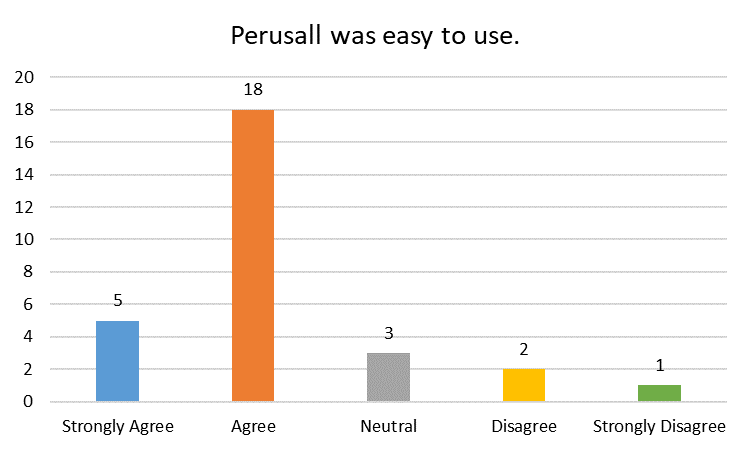
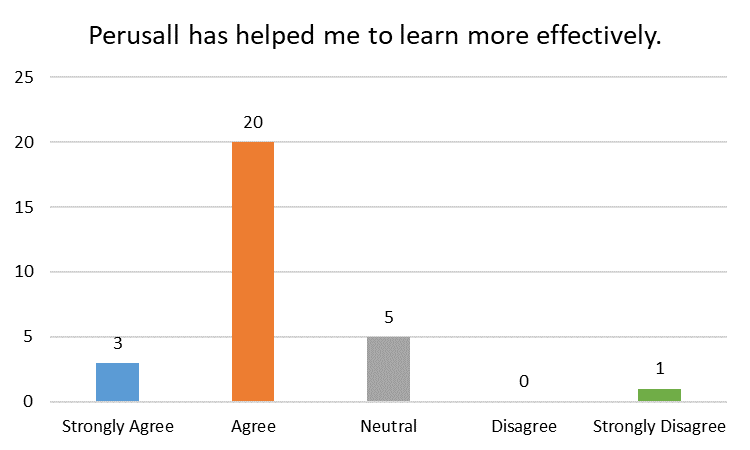
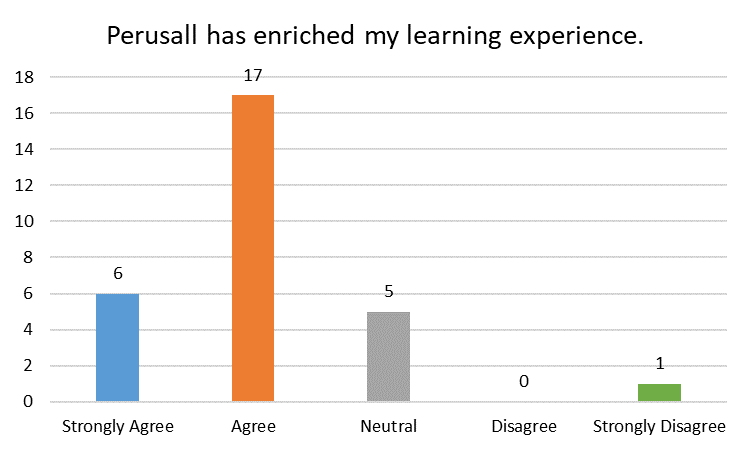

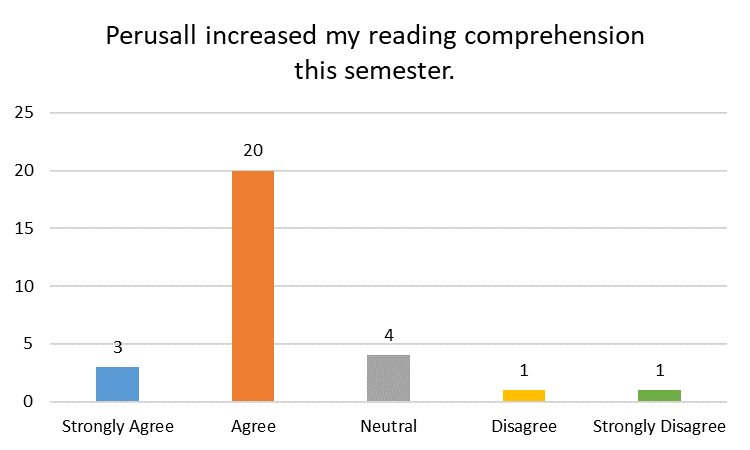
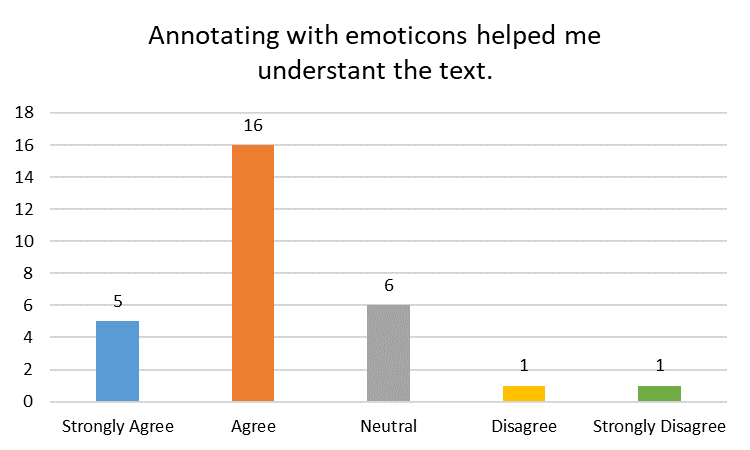
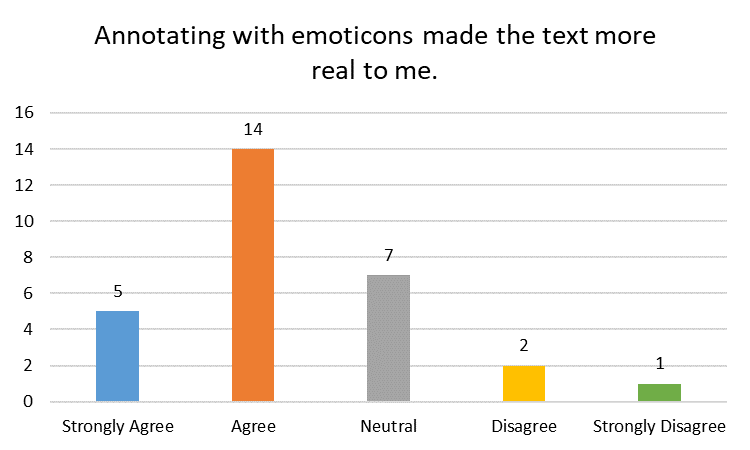
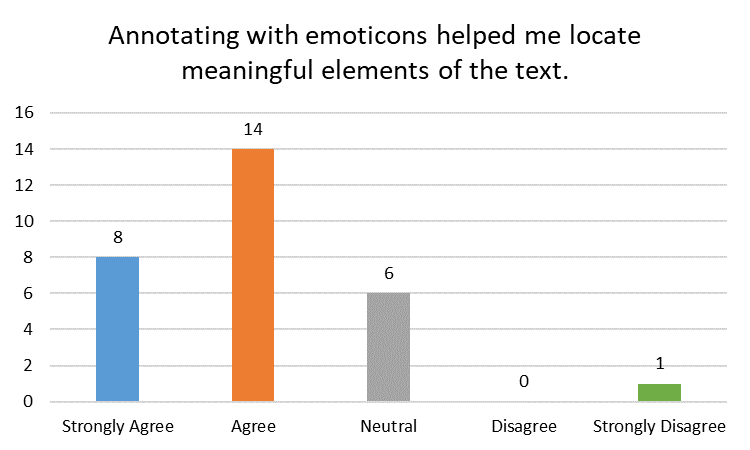
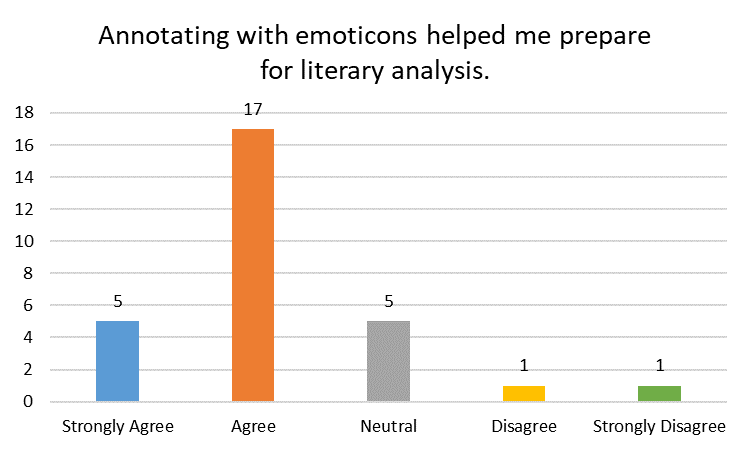
The following tools have been developed for social annotation:
Research on social annotation in higher education has been summarized in two meta-analyses.
Clapp et al 2020 has found that “New social annotation practices have the potential to become a “signature pedagogy” for educators in literary studies, because social annotation encapsulates both the expected learning outcomes and the underlying value commitments of literature education.” This demonstrates that there is a good fit between social annotation and literary studies.
In this assignment, students are told to annotate with their affective responses using emojis in order to capture their affective responses without language at first. Often students will annotate with emoticons, read the rest of the text and then use language.
Common observations include: